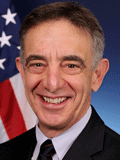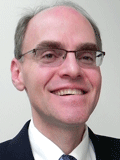ISQED'18 Keynotes
- Check out selected keynotes from previous years.
Tuesday & Wednesday March 13-14
Murphy Was an Optimist: Embracing Asymmetry in Electronics
 Kerry Bernstein
Kerry BernsteinKerry Bernstein - Microsystems Technology Office - Defense Advanced Research Projects Agency (DARPA)
The high performance digital microelectronic component is designed to do one thing – that is to faithfully execute its instruction set architecture. The resulting hardware embodiment, however, forces structure into materials that resist order. These structures immediately begin reverting to their lowest energy state and highest disorder. Semiconductor wear-out and aging are evidence of this entropy. Countering these effects is expensive, and contributes nothing to transaction throughput or energy efficiency. Against this backdrop, selected emerging concepts in device physics, process, design, architecture, reliability and hardware security may collectively embrace entropy, and use asymmetry in our favor. This talk will provide an overview of concepts that connect low level device physics to high level architecture in a way that leverages asymmetry in our favor. Given that current devices are confronting not just atomistic but now quantum-mechanical limitations to scaling, the need is greater than ever.
About Kerry Bernstein-
Kerry Bernstein is a program manager in the Microsystems Technology Office at the Defense Advanced Research Projects Agency (DARPA). His interests are in the area of hardware security and emerging high performance post-CMOS device technologies. Mr. Bernstein formerly spent 33 years at the IBM T.J. Watson Research Center and IBM Microelectronics, working in the areas of leading edge, high performance/low-power computing devices and circuits, and 3D Integration. He attributes any successes realized to be due in large part to being surrounded by wonderful people throughout his entire career. Mr. Bernstein received his B.S. (1978) in Electrical Engineering from Washington University in St. Louis, Missouri, and continued graduate work at the University of Vermont. He has co-authored four (4) textbooks, holds 155 patents, and is a Fellow of the Institute of Electrical and Electronics Engineers (IEEE).
AI Creating New Opportunities for Chip Designers
 Yankin Tanurhan
Yankin TanurhanYankin Tanurhan - Vice President Engineering, Synopsys
Rapid advances in artificial intelligence (AI) and machine learning are creating the next wave of opportunities for SoC designers. From facial recognition to surveillance monitoring to autonomous driving, AI is becoming must-have technology for an expanding number of tech applications. Neural networks, modeled after the human brain, have significantly improved developers’ ability to implement machine learning hardware and software in edge devices, particularly for object detection and embedded vision applications. This keynote presentation provides an industry perspective on AI trends and emerging uses.
About Yankin Tanurhan
Dr. Yankin Tanurhan is Vice President Engineering, DesignWare Processor Cores, IP Subsystems, Non-Volatile Memory at Synopsys leading low power and high-performance ARC and EV Embedded Processor developments targeted from Mobile, IoT, Embedded Vision, AI/ML, Digital Home, Automotive/Industrial, Security to Storage markets. His portfolio additionally includes ASIP tool development with products like ASIP Designer and Programmer, IP Subsystems products like Sensor Fusion, Audio, Vision and Security Subsystems and CMOS based Non-Volatile Memory IP development. Dr. Tanurhan has authored 100+ papers in refereed publications. He holds a B.S. and M.S. in Electrical and Computer Engineering from Rheinisch Westfaellische Technische Hochschule (RWTH) in Aachen, Germany and a Dr. Ing. degree summa cum laude in Electrical Engineering from the University of Karlsruhe (TH) in Karlsruhe, Germany.
Innovation in an Exponential World
 Nate Brese
Nate Brese Nate Brese - Marketing Fellow, Electronics & Imaging - DowDuPont
The interplay of design objectives, regulatory disruptions, performance criteria and materials innovations have enabled electronic devices to evolve in accord with roadmaps, “laws” and correlations over the past half century. New opportunities to lower cost and improve performance have led designers into the third dimension where packaging offers miniaturization and efficiency gains. As we approach the tipping point for interconnected devices of all sorts, materials and design ingenuity are in high demand. This talk will focus on key market drivers and challenges facing our industry. We will discuss recent materials and design innovations required by emerging applications as well as the roadmaps guiding us into the future.
About Nate Brese
Nate Brese is a Marketing Fellow in Strategic Marketing and Business Development within DowDuPont Electronics and Imaging. He currently leads acquisition and alliance strategy and has business development activities in a variety of high-growth market segments such as automotive, medical, and high-speed communication. Dr. Brese earned his B.A. in the Integrated Sciences Program at Northwestern Univ. and his Ph. D. in Solid State Chemistry from Arizona State Univ. He conducted postdoctoral research at the Max Planck Institut für Festkörperforschung in Stuttgart, Germany, and at Cornell Univ. He later completed the two-year Wharton Management Certification Program at Univ. Pennsylvania. As a research scientist and marketing professional at OSRAM Sylvania, Rohm and Haas, and Dow Electronic Materials, Nate has been instrumental in launching new products, creating business plans, assessing acquisition targets, and developing business opportunities in numerous areas, including phosphors, advanced packaging, industrial finishing, military optics, LEDs, and optical communication. He organized a Gordon Conference on Solid State Chemistry and a Materials Research Society Symposium on Solid State Chemistry. He is a member of the ACS, ECS, IEEE, MRS, and the Technical Committee of iNEMI. Nate is a co-inventor on over 20 US patents and co-author of 40 scientific papers.

